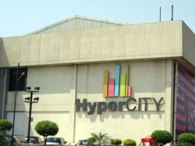 Raheja-owned Hypercity plans its growth on the back of quality merchandise rather than cheaper price points.
Raheja-owned Hypercity plans its growth on the back of quality merchandise rather than cheaper price points.A few months ago, an international business consultancy conducted a perception survey on how consumers perceive prices charged by different hypermarkets in Thane, near Mumbai.
Most respondents felt the Raheja-owned hypermarket chain Hypercity was among the most expensive ones.
Hypercity Chief Executive Officer Mark Ashman, however, says he is not convinced with the results of the survey given its thin participation, adding that Hypercity is competitive in many categories such as staples, food and so on.
A hypermarket is a larger version of a supermarket. Apart from food and groceries, it stocks apparel and general merchandise too, among other things.
Big retail chains like Reliance Retail, Aditya Birla Retail, Trent Hypermarket, D Mart and Spencer's are increasingly focusing on hypermarkets, which are considered essential for generating volumes and economies of scale for retailers. Some of these chains offer up to seven per cent discount on maximum retail price (MRP).
Ashman, however, feels attracting customers with discounts is a short-sighted strategy. "I can't see how it is ultimately sustainable? You are taking customers only on price. If you stop giving discounts, customers go away," he says.
In early 2009, when the economy was still reeling under slowdown, Ashman as the CEO of Mark's and Spencer Reliance India (M&S) had lowered the prices of some its products by 20 per cent. Ashman back then had told Business Standard that the strategy was aimed at retaining customers who were moving away to cheaper products.
Ashman is now planning a different strategy for Hypercity. When other chains are competing with each other on pricing, he says Hypercity wants to differentiate itself with different products and quality merchandise.
"If you go to most of the hypermarkets, everybody is selling the same plastic boxes, steel utensils and so on. We want to sell different products that are not available with others,'' the chief executive adds.
The chain wants to launch more international designs in its homeware and apparel - two of its focus areas. It has increased products of the UK-based Waitrose (with which it has an exclusive supply agreement) by 50 per cent and reduced prices of Waitrose products to attract buyers.
Launching imported products, however, is not unique to Hypercity. Tata's hypermarket chain Star Bazaar has already launched store brands of UK's Tesco (with which it has a franchise agreement) in personal care, health and food, among other things. RPG group's Spencer's and Aditya Birla's More also sell imported products.
With 27 per cent same store sales growth and growing number of stores, Ashman says there are no issues with topline. "We want to drive profitability with better margins,'' he says. He adds that the company wants to drive margins with a better mix of products.
"If we can reduce the percentage of food and increase the apparel from eight to 10 per cent next year and 12 per cent a year after that, we can do much better," he says.
Though food contributes to 57 per cent of Hypercity revenues, it carries gross margins of 10-15 per cent while apparel carries margins of 30-35 per cent.
Hypercity is also focusing on private labels to boost its margins. While it sells almost 100 per cent private labels in men's wear and plans to launch private labels in undergarments and socks. It also plans to increase the share of private labels in kidswear to 70 per from 50 per cent in the coming autumn.
Private labels are considered major margin drivers for retailers as they can be directly bought from vendors, thus saves marketing and advertising costs. Private labels in apparel range between 50 and 55 per cent, while that of food account for 30-35 per cent.
Arvind Singhal, chairman of business consultancy Technopak Advisors, says there are enough opportunities for premium products in hypermarkets and department stores. However, Hypercity's peers say premium has limited catchments.
"They had great success in certain areas like Malad in Mumbai, Hyderabad, Whitefield in Bangalore. But in cities like Jaipur, Thane and Bhopal, which do not have great catchments, they are yet to see success,'' says a senior executive of a retail chain who does not want to be quoted.
"It is not a hugely scalable model," the executive says. But Hypercity's management does not believe so. Last year, Hypercity Vice-Chairman BS Nagesh said the retail chain's current stores are set to break-even by 2012 and the chain will become profitable by 2013.
"I have no reason to disagree with Nagesh. We are capable of doing that," says Ashman. Hypercity posted sales of Rs 456.83 crore (Rs 4.56 billion) and a loss of Rs 50 crore (Rs 500 million) year to date till December 31, 2010.
Hypercity has eight stores now and plans to open in Ludhiana, Bangalore, Ahmedabad and Pune.








